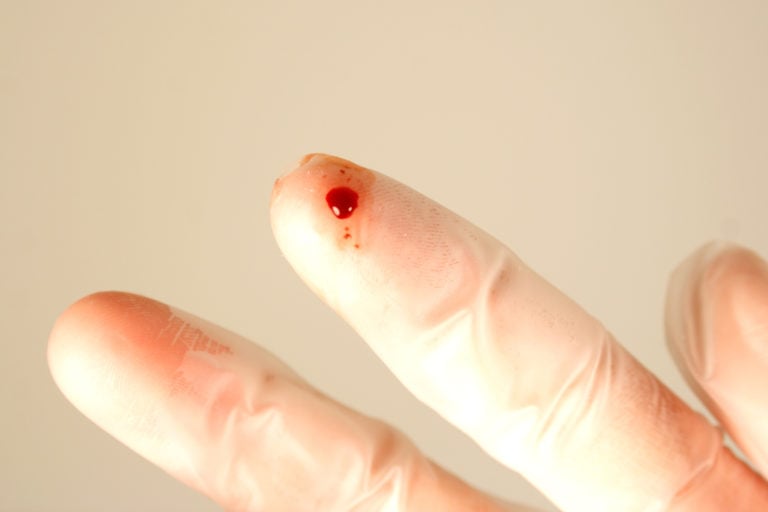What Happens If a Nurse Gets a Needlestick or Other Type of Exposure?

Sustaining a needlestick injury or other type of exposure is scary. According to the CDC, there is an average of 385,000 sharps-related injuries annually among healthcare workers. Healthcare workers are at risk for contracting diseases such as Hepatitis B or C as well as HIV – which can be terrifying. Despite legislation for needlestick prevention and safety measures in place, accidents do happen, and nurses need to know what to do in case of an exposure.
The actions taken after exposure depend on the type of exposure. For sharps/needlestick injuries, nurses should immediately wash the area with soap and water and "milk" the area to encourage bleeding. Viruses begin to multiply rapidly once in the bloodstream, so preventing entry into the bloodstream in the first place is extremely important. For splash exposures, nurses should scrub the area thoroughly with soap and water. For splash exposures involving mucous membranes (eyes, nose, mouth), irrigate the area well with water.
RELATED: Accident/Error and Incident Prevention: NCLEX-RN
Nurses should immediately report exposures to a supervisor. This is one of the largest problems; nurses are extremely busy and sometimes choose not to report right away. They may not want to "dump" their work on others and sometimes they are afraid of discipline for reporting a sharps injury. Some are even embarrassed, or are too frightened to face the possibility of contracting a disease or too much in shock to report. However, reporting should not be delayed – treatment should begin immediately to help prevent transmission of bloodborne pathogens.
Once reported to the provider, several things may happen at once. In some cases, the patient is contacted and blood work ordered to check Hepatitis B and C status as well as HIV. This is only if it is known where the exposure came from. Also, the patient must give consent to check blood work. Concurrently, the nurse would also get baseline lab work done. A Hepatitis B vaccine may also be indicated, and the nurse may choose the option of starting post-exposure prophylaxis (PEP) to reduce the transmission of HIV. Subsequent blood work (for at least six months) to monitor conversion status may also be indicated.
Nurses may also benefit from counseling services. As stated earlier, an exposure can be very stressful and scary, affecting not just the patient and nurse but the nurse's family as well. Some nurses feel like they "failed" by experiencing a needlestick or other type of exposure, playing the scenario back to find out how things could have been done differently.
Unfortunately, needlestick and other types of exposures happen. Nurses can reduce their risk by following safety measures and using needleless systems (when possible) and activating the safety device on sharps. Proper use of personal protective equipment (PPE) when performing a procedure or task that has a high risk of exposure to body fluids is also critical. Nurses should also avoid rushing and "cutting corners" as it could result in an accidental exposure.
RELATED: How Do Psychiatric Nurses / NPs Stay Safe on the Job?
For more information on what to do following an exposure, please visit the CDC website.
